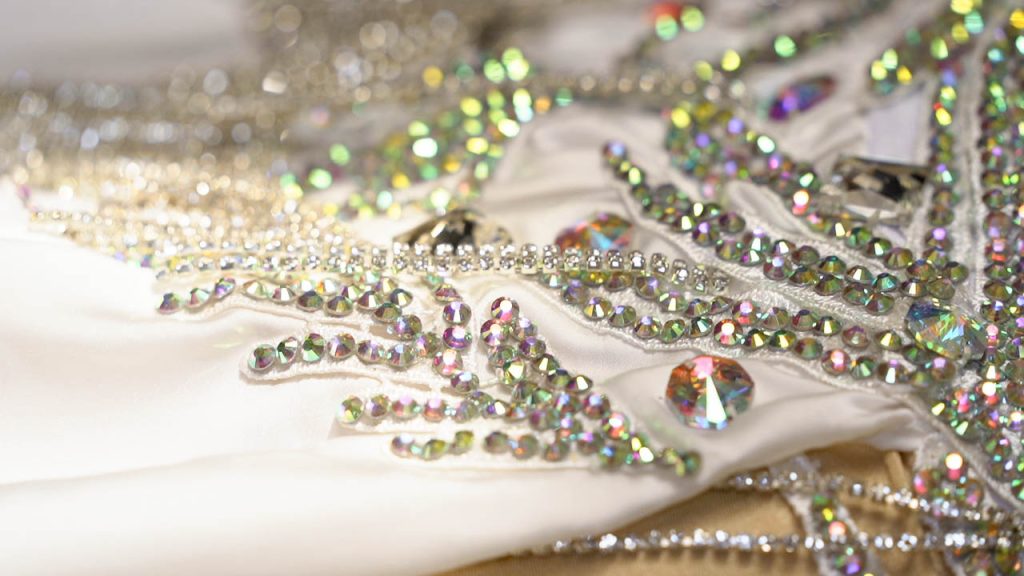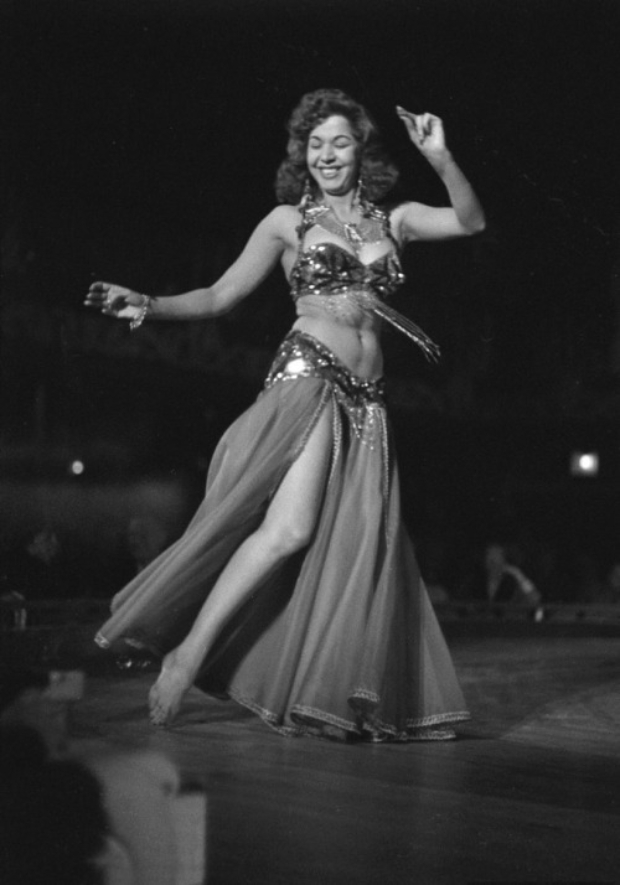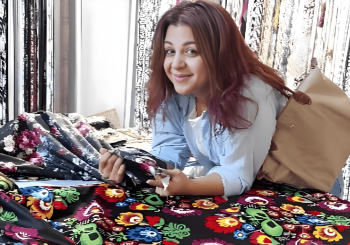Cairo: the city of a thousand dancers.
Swathed from head to toe with suits that are dotted with gleaming sequins and intricate embroidery of colorful threads, the rhythmic shakes of bellydancers’ curvaceous bodies have ensnared the attention of the Egyptian public—and beyond—for many eras. Their suits are a testament to decades of art and a history of dance in Egypt.
One of the artisans behind the suits that make Egypt’s belly dancers shine bright is none other than Om Aya: the lady whose reverent engagement with the craft and fondness for the art of belly dancing led her to become one of the most well-known suit designers in Cairo.
Om Aya is a craftswoman and artist—a designer who understands the bellydancers’ mobility of flowing gestures and the power it takes to navigate spaces on stage when making her suits.
It is an art she has mastered over the past 20 years.
Small Studio, Large Influence
In a small alley in the Imam Al-Shafei neighborhood in Cairo—one aswarm with tuk-tuks and street vendors—lives Om Aya. Luxor born, but having spent over 20 years in the capital, Om Aya’s passion for suit design started as a hobby that gradually grew into a pioneering business.
“When I was young, we had a neighbor that had a sewing machine, and I would always make up excuses to go watch her sew clothes,” Om Aya tells Egyptian Streets.“Through watching her, I began learning and understanding more about the intricacies of sewing and handmade work, and I grew to love it.”
Om Aya learned all the technicalities of clothes-making from her secondary school teacher in Luxor, who taught her everything there is to know about sewing, stitching, seaming, and hemming. After mastering the versatility of sewing and fabrics, she started making clothes for her children.
“It wasn’t until someone asked me to work with beads that I started designing bellydance suits. I designed and experimented with different styling until I reached where I am now,” the designer explains.
However, the road to success for Om Aya was quite treacherous. When she first started working, her siblings were not very fond of not just the idea of designing bellydance costumes, but working in general because they [her family]thought she didn’t need the money.
Despite it being a form of art and design, belly dance — as well as its costume design — has a negative reputation in Egypt, and Om Aya received various attacks for being a designer.
“At first, no one knew I was working, because I used to design the suits at my home, completely walled off from the world. It wasn’t until I started expanding and getting more known that people started attacking me, telling me that what I’m doing is haram (forbidden in Islam),” Om Aya underscores.
But Om Aya paid no heed to those who attacked her business; she believed in what she did: the workmanship, punctuality, precision, creativity, and patience it takes to create the suits.
“Making the suits is an art. They are a canvas like no other, where I get the chance to experiment and make my dreams come true,” she notes.
The city of Cairo: The landscape of Wonders
To Om Aya—and many aspiring entrepreneurs—Cairo represents an oasis of opportunities. Many women venture to Cairo from other governorates in pursuit of independence, education, and work opportunities.
Since the throes of the 1920s, the buzzing capital of Cairo’s dancehalls and stages saw a generation of belly dancers who pioneered oriental dance in Egypt.
The art of oriental dance is believed to have started by none other than Badia Masabani, who is better known as the ‘godmother’ of oriental dance. Masabani opened her famous Casino Badia on Emad el-Din street in Cairo in 1926, where she pioneered theatrical dance tools such as group choreography, movement-extending props, the deliberate use of space on stage, and many more elements of modern entertainment.
Masabani was also the source of inspiration for some of the most iconic dancers native to Egypt,and particularly Cairo,such as Taheyya Karioka, Samia Gamal, Naima Akef, and Beba Ezzedine.
Om Aya grew up watching Soheir Zaki, one of Egypt’s most prominent dancers in the 1960s, and drew inspiration for her designs from Zaki’s costumes.
“Soheir Zaki’s suits were magnificent, delicate, and beautiful—a testament to the delicacy of handmade work. I wish I could design costumes like what she used to wear,” Om Aya notes. “Unfortunately, no one until now asked me to replicate the costumes like they were done in the past, as worn by Badia Masbani and Samia Gamal.”

Although Cairo has always been known as the hub for belly dancing in Egypt, where belly dancers flourished and emerged, the sentiment surrounding the art of belly dancing, much like the costumes, has changed and evolved over the years.
From the 1920s until today, every decade was represented by its own costumes and prominent dancers alike.
The era from the 1920s until the 1940s was characterized by Masbani’s suits, largely identified by the accessories in the hands, chest, and head areas. The 1950s was characterized by Egypt’s iconic dancers, such as Samia Gamal, Naima Akef, and Taheyya Karioka, who had different shapes and inscriptions on all sides of their costumes.
In the 1960s, the dance suits drew inspiration from the trending ‘charleston’ pants that appeared during the time, which led to the creation and popularization of two-piece suits consisting of wide pants and tops.
In the 1970s and 80s, the dancers—amongst them Najwa Fouad and Fifi Abdo—started wearing suits that were covered from the abdomen and were primarily formed from the lycra fabric. In the 1990s, the colorful lycra continued to be more prominent, with the rise of sham’adan belly dancing, often known as the Candelabra Dance, an art of dancing while balancing candles on the head.
“With the change in dancers came a change in costumes. The costumes that were worn in the 1950s until the 1970s differ from those in the 2000s [up until today]. It’s not just that the costumes have changed, but also the music, trends, and styles have shifted and evolved throughout the decades,” Om Aya highlights.
The designer also noted that the modern costumes that belly dancers want to wear have changed the essence of suit design as a job.
“Nowadays, most of the well-known belly dancers’ costumes do not require the delicacy and refinement of sewing and detailing like in the past, where handmade work was exceptional,” Om Aya says.
As the art of costume design and dance shifts and transforms with the ever-changing tides of trends and time, the only thing that remains the same is Cairo—a city diverse in its art.
“I thought about opening in other cities and governorates in Egypt, but Cairo will always remain the most feasible place. Not only is it the hub of belly dancing, where most belly dancers reside and where shops are the most diverse, but it is also a city with endless possibilities,” Om Aya tells Egyptian Streets.







Comments (0)